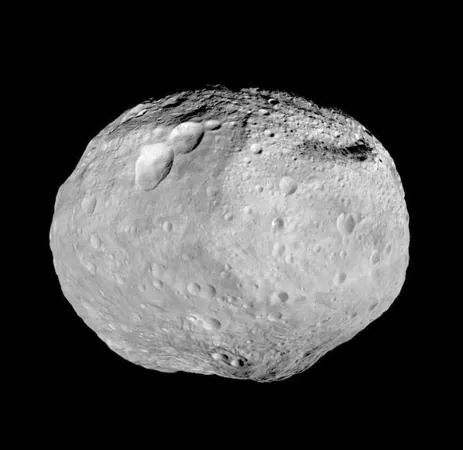
Unveiling the Mysteries of Vesta: A Surprising Lack of Metallic Core
2025-04-28
Author: Jia
Vesta's Shocking Revelation: No Metallic Core?
In a stunning twist that has left scientists buzzing, new research indicates that Vesta, the second largest asteroid in our Solar System, may not possess a traditional metallic core. This groundbreaking finding comes from an analysis of data obtained by NASA’s Dawn spacecraft.
Vesta: The Eye-Catching Asteroid We Thought We Knew
Discovered back on March 29, 1807, by Heinrich Wilhelm Olbers, Vesta is not just any asteroid; it’s the lone main-belt asteroid visible to the naked eye. With a swift rotation of just 5.34 hours and an orbit around the Sun every 3.63 years, this ellipsoidal giant spans 286 x 279 x 223 kilometers.
The Mystery of Vesta's Formation
For years, scientists have considered Vesta a differentiated body resembling our own Earth, featuring distinct layers of core, mantle, and crust. However, new findings provoke a deeper inquiry into its true nature.
Dr. Seth Jacobson from Michigan State University and his team propose two fascinating hypotheses: Firstly, Vesta may have undergone incomplete differentiation, initiating the melting process for layer formation but failing to finish. Alternatively, it could be a fragment from a larger, growing planet within the early Solar System.
A Decade of Research Leads to Groundbreaking Insights
Dr. Ryan Park from NASA's Jet Propulsion Laboratory highlighted the challenges faced due to conflicting gravity data in previous studies. After nearly ten years of refining their techniques, the team achieved remarkable clarity and alignment between different data sources, unveiling Vesta's complex internal structure.
A New Way to Understand Celestial Bodies
The researchers found that Vesta's behavior deviates from what one would expect from an asteroid with a core. This revelation necessitates the development of new models to assess whether Vesta is indeed an ancient fragment of a planet still in the making. Dr. Jacobson notes that these insights could prompt scientists to revisit how they analyze Vesta meteorites, using innovative methods informed by the new Dawn mission data.
A Game-Changer for Planetary Science
This research, published in the journal Nature Astronomy, is just the beginning of a revolutionary shift in how scientists perceive differentiated worlds. With Vesta’s secrets unraveling, who knows what other mysteries of the cosmos await discovery?

 Brasil (PT)
Brasil (PT)
 Canada (EN)
Canada (EN)
 Chile (ES)
Chile (ES)
 Česko (CS)
Česko (CS)
 대한민국 (KO)
대한민국 (KO)
 España (ES)
España (ES)
 France (FR)
France (FR)
 Hong Kong (EN)
Hong Kong (EN)
 Italia (IT)
Italia (IT)
 日本 (JA)
日本 (JA)
 Magyarország (HU)
Magyarország (HU)
 Norge (NO)
Norge (NO)
 Polska (PL)
Polska (PL)
 Schweiz (DE)
Schweiz (DE)
 Singapore (EN)
Singapore (EN)
 Sverige (SV)
Sverige (SV)
 Suomi (FI)
Suomi (FI)
 Türkiye (TR)
Türkiye (TR)
 الإمارات العربية المتحدة (AR)
الإمارات العربية المتحدة (AR)